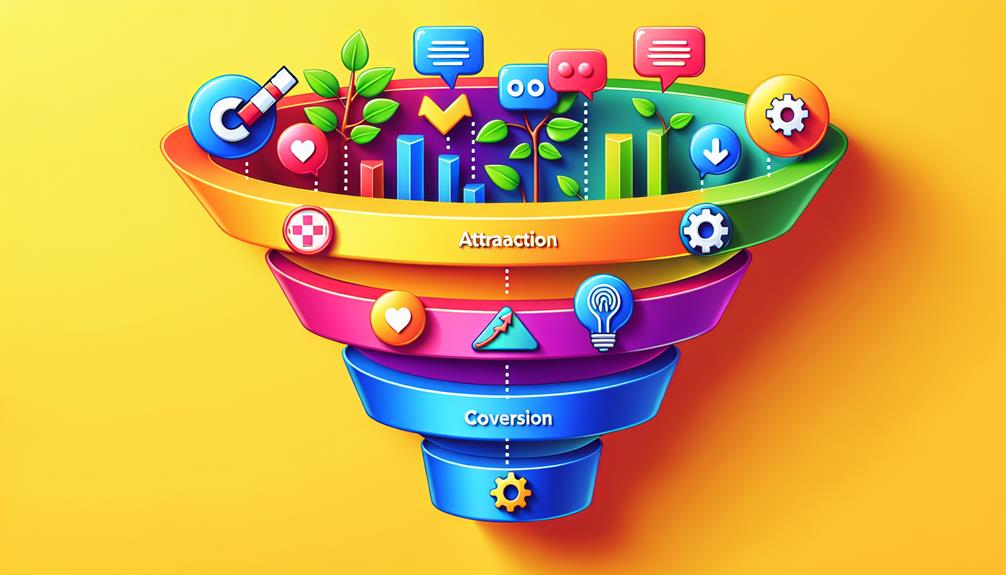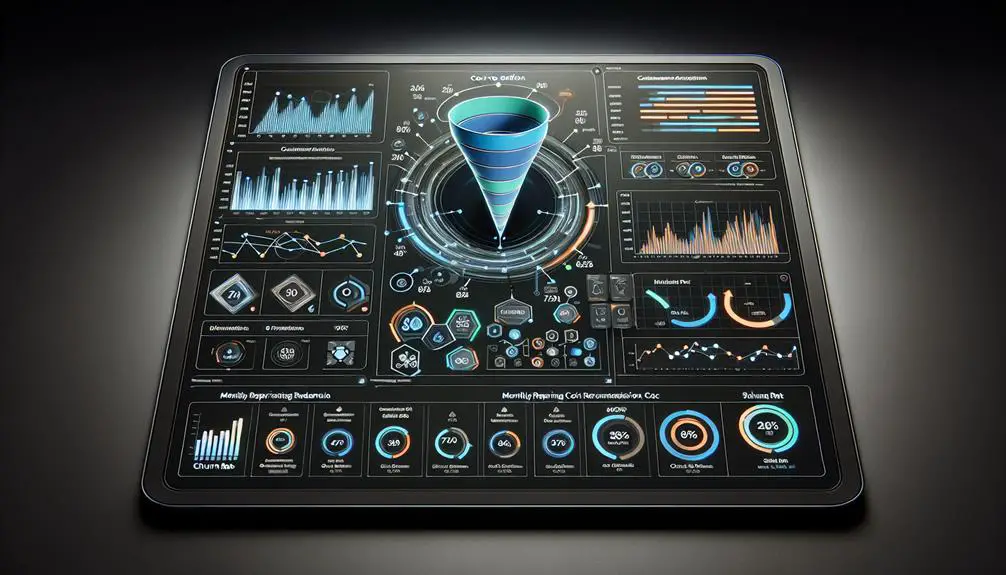Imagine you're on a road trip, and your SaaS funnel metrics are your map and compass, guiding your journey towards growth. You wouldn't set off without knowing your route, right?
Similarly, understanding which metrics to track at each stage of your funnel – from acquisition and activation to retention and revenue – is crucial. These indicators, like customer acquisition cost and retention rate, act as signposts, showing you where to speed up and where to take a detour.
Now, let's explore how you can optimize these metrics to fuel your growth engine, ensuring you don't just reach your destination but enjoy the ride too.
Contents
Key Takeaways
- Monitoring funnel metrics like customer retention and conversion rates is crucial for SaaS growth.
- Tracking acquisition metrics, such as free trial signups and Customer Acquisition Cost, informs effective marketing strategies.
- Enhancing user onboarding and feature adoption boosts activation and retention rates, key for long-term success.
- Utilizing tools like Google Analytics and conducting A/B testing are essential for optimizing funnel performance and making data-driven decisions.
Understanding Funnel Metrics
To really get a handle on how your SaaS business is performing, it's crucial to understand funnel metrics. These metrics are like the roadmap of your customer's journey, from the moment they show interest in your service to the point where they become loyal fans. By tracking and measuring these metrics, you can pinpoint exactly where you're doing great and where there's room for improvement.
Think of your SaaS funnel as a storybook of your customer's experience. Metrics such as customer retention, conversion rates, and revenue growth give you a clear picture of this narrative. They help you understand not just how many people are moving through your sales funnel, but also how effectively they're doing so. This insight is invaluable because it directs your focus towards strategies that enhance growth and solidify customer loyalty.
Moreover, tracking these metrics ensures that your team remains aligned with clear, data-driven goals. It's not just about increasing numbers; it's about fostering a healthy, growing relationship with your customer base. So, dive deep into understanding these metrics. They're your compass for navigating the complexities of SaaS growth and ensuring your business thrives in the competitive market.
Acquisition Stage Insights
As we dive into the Acquisition Stage of the SaaS funnel, it's essential to understand that tracking free trial signups and demos is key to gauging how well you're converting interested prospects into potential customers. This stage is your first real test in turning interest into concrete action.
By monitoring who signs up for free trials or requests demos, you're pinpointing Product Qualified Leads (PQLs). These are the folks who've shown a genuine nibble at your product, a crucial step toward becoming paying customers.
But don't stop there. Dive deeper by examining your conversion rates from leads to trials. This metric sheds light on the effectiveness of your lead generation efforts. Are you attracting the right audience? If your conversion rates are low, it might be time to tweak your targeting strategies.
Equally important is evaluating your Customer Acquisition Cost (CAC). This number, when viewed alongside other acquisition metrics, guides you in optimizing your marketing spend. It's not just about spending less, but spending smarter.
Activation and Retention Strategies

Once you've attracted potential users, the next crucial steps are activating them and keeping them engaged with your product. To boost your activation rate, focus on streamlining user onboarding. A smooth onboarding process significantly enhances customer satisfaction and paves the way for higher retention. Pay attention to how quickly users find value in your SaaS – this is known as Time to Value (TTV). The faster they see the benefits, the more likely they'll stick around.
Feature adoption is another key area. Guide your users to understand and use the core features that solve their problems. This not only improves the activation rate but also contributes to long-term retention.
Now, let's talk retention strategies. Monitoring your customer churn rate and retention rate gives you a clear picture of how well you're keeping users. High customer satisfaction is often a predictor of low churn rates. By analyzing these metrics, you can identify at-risk customers early and take action. Enhancing product features and offering exceptional customer service are proven ways to boost retention.
Referral and Revenue Analysis
Diving into referral and revenue analysis, you'll uncover valuable insights that can propel your SaaS's growth by understanding how customers advocate for your product and what drives your revenue. Referral analysis isn't just about counting how many people mention your service; it's about diving deep into NPS scores and customer satisfaction metrics. These figures show you who's recommending your product and why, giving you a clear picture of your advocacy and word-of-mouth recommendations.
On the flip side, revenue analysis takes you through a journey of numbers that matter: Average Revenue Per User (ARPU), Expansion MRR, and Customer Lifetime Value (CLV). These metrics are your best friends in identifying where your revenue is coming from and how you can grow it. By keeping an eye on referral conversion rates, you're not just tracking numbers, but understanding customer advocacy behavior. This knowledge is golden for optimizing your referral programs for organic growth.
Moreover, analyzing metrics like Expansion MRR helps in spotting upselling and cross-selling opportunities, while understanding the referral stage metrics can leverage customer feedback to boost referrals and, ultimately, increase customer lifetime value.
Optimizing Funnel Performance

Understanding your referral and revenue metrics is crucial, but optimizing your funnel performance is where you'll see real growth. With tools like Google Analytics and Mixpanel, you can dive deep into tracking funnel metrics, especially focusing on user behavior. This insight allows you to tweak and test different strategies for optimization.
Implementing A/B testing is a powerful way to compare funnel variations. By analyzing which version yields higher conversion rates, you're equipped to make informed decisions. Remember, it's all about finding what resonates with your users.
Monitoring conversion rates at each stage of your SaaS sales funnel is key. It helps identify where potential customers might be losing interest or facing obstacles. Making timely improvements based on these insights can significantly enhance funnel performance.
Cohort analysis is another gem for tracking user behavior over time. This approach helps you understand how changes in your funnel affect different groups of users, enabling you to tailor optimization strategies more effectively.
Lastly, regular review and analysis of your funnel metrics are vital. This habit ensures that your decisions are data-driven, keeping your growth strategies sharp and effective.
| Strategy | Benefit |
|---|---|
| A/B Testing | Identifies effective funnel variations |
| Conversion Rate Monitoring | Pinpoints stages needing improvement |
| Cohort Analysis | Tracks long-term user behavior changes |
| User Behavior Tracking | Guides optimization efforts |
| Regular Review | Ensures data-driven decision making |
Frequently Asked Questions
What Are Funnel Metrics for Growth?
You're asking about funnel metrics for growth, right? They're key indicators like acquisition, activation, retention, referral, and revenue that help you understand user behavior, pinpoint issues, and make informed decisions to grow your SaaS business.
How Do You Calculate Funnel Metrics?
You're about to become the Sherlock Holmes of funnel metrics! Start by tracking actions at each stage, then dive into conversion rates and customer costs. Use tools like Google Analytics for precision. It's elementary, really!
What Are the KPI Stages of the Funnel?
The KPI stages of the funnel are Acquisition, Activation, Retention, Referral, and Revenue. You'll focus on specific metrics at each stage to measure progress, optimize strategies, and improve the customer experience for growth.
How Do You Track Sales Funnel?
Imagine diving deep into your sales funnel, it's easier than you think. Use tools like Google Analytics for insights, track user actions with event tracking, and measure marketing success with conversion tracking for growth.


